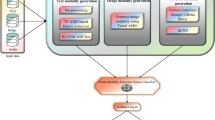Abstract
Cyberbullying can be delineated as a purposive and recurrent act, which is aggressive in nature, done via different social media platforms such as Facebook, Twitter, Instagram and others. While existing approaches for detecting cyberbullying concentrate on unimodal approaches, e.g., text or visual based methods, we proposed a deep learning based early identification framework which is a multimodal (textual and visual) approach (inspired by the informal nature of social media data) and performed a broad analysis on vine dataset. Early identification framework predicts a post or a media session as bully or non-bully as early as possible as we have processed information for each of the modalities (both independently and fusion-based) chronologically. Our multimodal feature-fusion based experimental analysis achieved 0.75 F-measure using ResidualBiLSTM-RCNN architecture, which clearly reflects the effectiveness of our proposed framework. All the codes of this study are made publicly available on paper’s companion repository.












Similar content being viewed by others
References
Agrawal S, Awekar A (2018) Deep learning for detecting cyberbullying across multiple social media platforms. In: European Conference on Information Retrieval, Springer, pp 141–153
Badjatiya P et al (2017) Deep learning for hate speech detection in tweets. In: Proceedings of the 26th international conference on world wide Web companion, pp 759–760
Basu T, Murthy CA (2012) A feature selection method for improved document classification. In: International conference on advanced data mining and applications, Springer, pp 296–305
Cambria E et al (2013) Sentic blending: Scalable multimodal fusion for the continuous inter- pretation of semantics and sentics. In: 2013 IEEE symposium on computational intelli- gence for human-like intelligence (CIHLI), IEEE, pp 108–117
Cer D, et al (2018) Universal sentence encoder. In: arXiv:1803.11175
Dietterich TG (1998) Approximate statistical tests for comparing supervised classification learning algorithms. Neural Comput 10.7:1895–1923
Dinakar K, Reichart R, Lieberman H (2011) Modeling the detection of textual cyberbullying. In: Fifth international AAAI conference on weblogs and social media
Djuric N et al (2015) Hate speech detection with comment embeddings. In: Proceedings of the 24th international conference on world wide Web, pp 29–30
Glorot X, Bengio Y (2010) Understanding the difficulty of training deep feed- forward neural networks. In: Proceedings of the Thirteenth international conference on artificial intelligence and statistics, pp 249–256
Goodman LA (1961) Snowball sampling. In: The annals of mathematical statistics, pp 148–170
Hosseinmardi H et al (2015) Analyzing labeled cyberbullying incidents on the instagram social network. In: International conference on social informatics, Springer, pp 49–66
Kumari K, Singh JP (2020) Identification of cyberbullying on multi-modal social media posts using genetic algorithm. In: Transactions on Emerging Telecommunications Technologies, pp e3907
Kumari K et al (2019) Towards Cyberbullying-free social media in smart cities: a unified multi-modal approach. In: Soft Computing, pp 1–12
Kumari K et al (2019) Aggressive social media post detection system containing symbolic images. In: Conference on e-Business, e-Services and e-Society, Springer, pp 415–424
Lipton ZC, Elkan C, Narayanaswamy B (2014) Thresholding classifiers to maximize f1 score. In:
Meng TL, Khushi M (2019) Reinforcement learning in financial markets. Data 4.3 :110
Nuzzo R (2014) Scientific method: statistical errors. Nature News 506.7487:150
Paul Sayanta, Jandhyala SK, Basu T (2018) Early detection of signs of anorexia and depression over social media using effective machine learning frame- works . In: CLEF (Working notes)
Peng Y, Qi J, Yuan Y (2018) Modality-specific cross-modal similarity mea- surement with recurrent attention network. IEEE Trans Image Process 27.11:5585–5599
Pinheiro P, Collobert R (2014) Recurrent convolutional neural networks for scene labeling. In: International conference on machine learning, pp 82–90
Poria S et al (2015) Towards an intelligent framework for multimodal affective data analysis. Neural Netw 63:104–116
Poria S et al (2017) A review of affective computing: From unimodal analysis to multi- modal fusion. Inform Fusion 37:98–125
Prakash A, et al (2016) Neural paraphrase generation with stacked residual lstm networks. In: arXiv:1610.03098
Qureshi SA et al (2019) Multitask representation learning for multimodal estimation of depression level. IEEE Intel Syst 34.5:45–52
Rafiq RI et al (2015) Careful what you share in six seconds: Detecting cyberbullying instances in Vine. In: 2015 IEEE/ACM international conference on advances in social networks analysis and mining (ASONAM), IEEE, pp 617–622
Rafiq RI et al (2016) Analysis and detection of labeled cyberbullying instances in Vine, a video-based social network. Soc Netw Anal Mining 6.1:88
Reynolds K, Kontostathis A, Edwards L (2011) Using machine learning to detect cyberbullying. In: 2011 10th international conference on machine learning and applica- tions and workshops, Vol 2, IEEE, pp 241–244
Smith PK et al (2008) Cyberbullying: Its nature and impact in secondary school pupils. J Child Psychol Psychiatry 49.4:376–385
Sun S, Xie Z (2017) Bilstm-based models for metaphor detection. In: National CCF conference on natural language processing and chinese computing, Springer, pp 431–442
Targ S, Almeida D, Lyman K (2016) Resnet in resnet: Generalizing residual architectures. In: arXiv:1603.08029
Wold S, Esbensen K, Geladi P (1987) Principal component analysis. Chemo- Metrics and Intelligent Laboratory Systems 2.1-3:37–52
Acknowledgments
We would like to express our gratitude to Rahat et al. [25, 26] for sharing their labeled multimodal dataset, Vine. Dr. Sriparna Saha gratefully acknowledges the Young Faculty Research Fellowship (YFRF) Award, supported by Visvesvaraya Ph.D. Scheme for Electronics and IT, Ministry of Electronics and Information Technology (MeitY), Government of India, being implemented by Digital India Corporation (formerly Media Lab Asia) for carrying out this research.
Author information
Authors and Affiliations
Corresponding author
Additional information
Publisher’s note
Springer Nature remains neutral with regard to jurisdictional claims in published maps and institutional affiliations.
https://github.com/sayantapaul/Multimodal-Cyberbullying-Identification
Rights and permissions
About this article
Cite this article
Paul, S., Saha, S. & Hasanuzzaman, M. Identification of cyberbullying: A deep learning based multimodal approach. Multimed Tools Appl 81, 26989–27008 (2022). https://doi.org/10.1007/s11042-020-09631-w
Received:
Revised:
Accepted:
Published:
Issue Date:
DOI: https://doi.org/10.1007/s11042-020-09631-w




